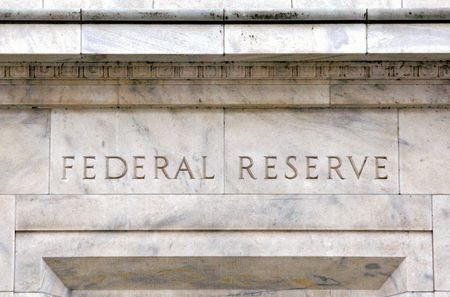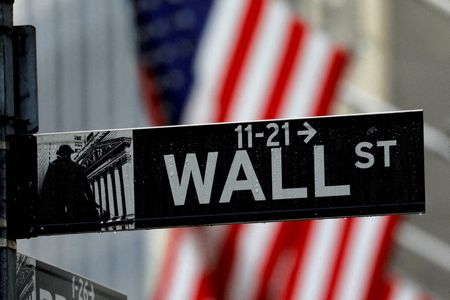By Saeed Azhar and Amruta Khandekar
NEW YORK (Reuters) – The S&P 500 ended nearly flat on Friday as gains in defensive sectors and energy offset weakness in megacap growth stocks, while investors looked toward next week’s speech by Federal Reserve Chair Jerome Powell.
Megacap technology-related growth stocks dipped, with Alphabet down 1.9% and Tesla falling 1.7%, as investors fretted that interest rates could stay higher for longer.
The tech-heavy Nasdaq posted the biggest weekly decline of the three major indices, losing 2.6%.
With no major catalysts driving markets, focus has shifted to Powell’s speech at the Jackson Hole economic symposium next Friday for clues on the interest rate outlook as well as earnings from chip designer Nvidia on Wednesday.
The S&P 500 lost 0.65 points, or 0.01%, to 4,369.71 and the Nasdaq Composite dropped 26.16 points, or 0.2%, to 13,290.78.
The Dow Jones Industrial Average rose 25.83 points, or 0.07%, to 34,500.66 points.
The CBOE volatility index hit its highest in nearly three months, reflecting rising investor anxiety.
Nvidia’s shares fell 0.1%, but still notched a weekly gain. Nvidia has had a spectacular rally on expected growth in artificial intelligence, nearly tripling in value year to date.
Defensive sectors such as consumer staples and utilities rose, with gains in firms such as retailer Walmart helping the Dow Jones Industrial Average.
The S&P 500 energy index rose 0.9%, with Exxon Mobil among leading gainers, up 1.5%.
Among major movers of the day, Estee Lauder tumbled 3.3% after the cosmetics maker forecast its annual net sales and profit below Street estimates.
The Nasdaq has fallen 7.2% in the past three weeks, its deepest three-week drop since late December. The S&P 500’s three-week loss of 4.6% is its biggest such decline since the three weeks ending on March 10.
This week’s losses came after a spate of strong economic data caused investors to dial back expectations of rate cuts and drove up government bond yields.
“We’ve long been overdue for a correction in equities, and it’s clear that higher rates have now become the catalyst for that,” said Michael Reynolds, vice president investment strategy
at investment and wealth advisory firm Glenmede.
“When the opportunity cost for capital becomes more competitive, valuations should correct on risk bearing assets, especially large cap equities which have been trading at significant premiums this year.”
Benchmark 10-year U.S. Treasury yields dropped from 10-month highs after they approached – but failed to break through – levels that would have been the highest since 2007 on Thursday.
Traders see a nearly 91% chance of the Fed holding rates at current levels at its September meeting, according to the CME Group’s FedWatch tool.
Hawaiian Electric shares surged 14% after the utility firm said its goal was not to restructure the company.
Shares of cryptocurrency firm Coinbase Global fell 3% and Riot Platform tumbled nearly 5.5% as bitcoin hit a two-month low.
Volume on U.S. exchanges was relatively light, with 10.6 billion shares traded, compared to an average of 11.0 billion shares over the previous 20 sessions.
Advancing issues outnumbered falling ones within the S&P 500 by a 1.5-to-one ratio.
The S&P 500 posted no new highs and 17 new lows; the Nasdaq recorded 24 new highs and 225 new lows.
(Reporting by Amruta Khandekar and Shristi Achar A in Bengaluru and Saeed Azhar in New York; Editing by Maju Samuel and David Gregorio)


